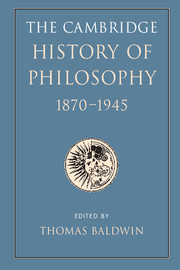Book contents
- Frontmatter
- Contents
- List of contributors
- Introduction
- I 1870–1914
- 1 Positivism, Idealism, and Pragmatism
- 2 Psychology and Philosophy
- 3 Logic, mathematics, and judgement
- 4 Philosophy and the new physics
- 13 The atomism debate
- 14 Theories of space-time in modern physics
- 5 The idea of social science
- 6 Ethics, politics, and legal theory
- 7 Philosophy of religion and art
- Interlude
- II 1914–1945
- Biobibliographical appendix
- Bibliography
- INDEX
- References
14 - Theories of space-time in modern physics
from 4 - Philosophy and the new physics
Published online by Cambridge University Press: 28 March 2008
- Frontmatter
- Contents
- List of contributors
- Introduction
- I 1870–1914
- 1 Positivism, Idealism, and Pragmatism
- 2 Psychology and Philosophy
- 3 Logic, mathematics, and judgement
- 4 Philosophy and the new physics
- 13 The atomism debate
- 14 Theories of space-time in modern physics
- 5 The idea of social science
- 6 Ethics, politics, and legal theory
- 7 Philosophy of religion and art
- Interlude
- II 1914–1945
- Biobibliographical appendix
- Bibliography
- INDEX
- References
Summary
INTRODUCTION
Among the most important events of twentieth-century physics, we must surely count the development of the special and the general theories of relativity by Einstein in 1905 and 1916, and that of quantum mechanics, which was worked out about ten years later by Bohr, Heisenberg, Schrödinger, and de Broglie. Owing to these theories, the physicist’s conception of space-time underwent two major upheavals.
Although they apply on different scales, the general theory of relativity and the quantum field theory play a fundamental role in describing the natural world, so a complete description of nature must encompass both of them. The formal attempt to quantise general relativity, however, leads to nonsensical infinite formulas. In the sixties non-Abelian gauge theory emerged as a framework for describing all natural forces except gravity; however, at the same time, the inconsistency between general relativity and quantum field theory emerged clearly as the limitation of twentieth-century physics. The resulting problem is a theorists’ problem par excellence: experiments provide little help, and the inconsistency illustrates the intermingling of philosophical, mathematical, and physical thought.
It is a fact of great significance that every physical theory of some generality and scope, whether it is a classical or a quantum theory, a particle or a field theory, presupposes a space-time geometry for the formulation of its laws and for its interpretation, and the choice of this geometry predetermines to some extent the laws which are taken to govern the behaviour of matter. Thus Newton’s classical mechanics (and especially its law of gravitation) is based on the assumption of an absolute simultaneity relation between events and a Euclidean geometry; similarly, the physical principle of the universal proportionality of inertial and gravitational mass, as recognised by Einstein between 1907 and 1915, requires the assignment of a non-integrable, that is, path-dependent, linear connection with non-vanishing curvature to space-time (the law of parallel displacement).
- Type
- Chapter
- Information
- The Cambridge History of Philosophy 1870–1945 , pp. 207 - 218Publisher: Cambridge University PressPrint publication year: 2003
References
- 1
- Cited by



